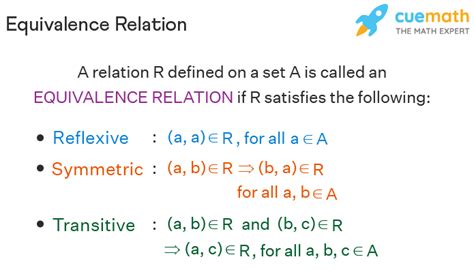Equivalence Relation Definition

In the realm of mathematics, specifically within the field of set theory, the concept of an equivalence relation plays a pivotal role. It is a fundamental notion that allows us to establish a connection between elements of a set, grouping them together based on certain criteria. This relation, though seemingly simple, has profound implications and applications across various branches of mathematics and beyond.
Unveiling the Equivalence Relation

At its core, an equivalence relation is a way to partition a set into subsets, ensuring that each subset contains elements that are in some way equivalent or related to each other. This relation is characterized by three essential properties, often referred to as the reflexive, symmetric, and transitive properties.
The Three Pillars of Equivalence
Let’s delve into these properties to understand their significance:
- Reflexive Property: This property states that every element is related to itself. In simpler terms, a is equivalent to a for all elements a in the set. This property ensures that the relation includes the diagonal of the set's matrix.
- Symmetric Property: If two elements are related, the relation holds in both directions. If a is equivalent to b, then b is also equivalent to a. This property establishes a kind of "mutual" or "reciprocal" relationship.
- Transitive Property: This property is perhaps the most intriguing. It states that if a is equivalent to b and b is equivalent to c, then a must also be equivalent to c. In essence, the relation "transfers" along the chain of equivalence.
These three properties together define an equivalence relation. They ensure that the relation is well-behaved and consistent, allowing us to draw meaningful conclusions and perform operations on the sets.
Equivalence Classes and Partitions
When an equivalence relation is defined on a set, it naturally partitions the set into subsets known as equivalence classes. Each element in the set belongs to exactly one equivalence class. These classes represent the distinct “groups” or “categories” that the elements can be assigned to based on their equivalence.
For example, consider the set of all triangles in geometry. We can define an equivalence relation based on their side lengths. Triangles with the same side lengths will belong to the same equivalence class. This classification helps us analyze and compare triangles more efficiently.
| Triangle Type | Side Lengths |
|---|---|
| Equilateral | Equal sides |
| Isosceles | Two equal sides |
| Scalene | All sides different |

Applications and Implications

The concept of equivalence relations finds applications in a myriad of mathematical and computational domains. From abstract algebra and number theory to computer science and physics, equivalence relations offer a powerful framework for analysis and problem-solving.
Number Theory and Congruence
In number theory, equivalence relations are fundamental to the concept of congruence. Congruence relations allow us to establish equivalence classes among integers, leading to the study of modular arithmetic and its applications in cryptography and computer science.
For instance, the relation a is congruent to b modulo n, denoted as a ≡ b (mod n), is an equivalence relation. It partitions the integers into classes based on their remainder when divided by n.
Group Theory and Symmetry
Equivalence relations are intimately connected to the study of symmetry in group theory. The symmetric group of a set is the group of all bijective functions from the set to itself, and it arises naturally from the equivalence relations on the set.
Consider the set of all rotations and reflections of a square. These transformations form an equivalence relation, as they preserve the fundamental properties of the square. This relation gives rise to the dihedral group, a key example in group theory.
Set Theory and Relations
In the broader context of set theory, equivalence relations are used to define and study equivalence sets and quotient sets. These concepts are crucial in the development of advanced mathematical structures and in the formulation of mathematical theories.
For example, the set of all rational numbers can be defined as the quotient set of the integers by the equivalence relation of equality. This approach provides a more abstract and elegant way to understand and work with rational numbers.
Future Prospects and Extensions
The study of equivalence relations continues to evolve and inspire new directions in mathematics. Modern research explores generalizations and variations of equivalence relations, such as partial equivalence relations and preorders, which have found applications in areas like computer science and category theory.
Additionally, the interplay between equivalence relations and other mathematical structures, such as topological spaces and algebraic structures, opens up exciting avenues for exploration and discovery.
How is an equivalence relation different from other types of relations?
+An equivalence relation is distinct from other types of relations, such as partial orders, in that it satisfies the additional symmetric and transitive properties. These properties ensure that the relation is well-defined and that elements within the same equivalence class are truly equivalent.
Can an equivalence relation have more than one equivalence class?
+Absolutely! In fact, it is common for an equivalence relation to partition a set into multiple equivalence classes. Each class represents a unique “type” or “category” of elements, based on their mutual equivalence.
Are there any real-world examples of equivalence relations beyond mathematics?
+Indeed, equivalence relations are prevalent in various domains. For instance, in chemistry, elements in the same group of the periodic table exhibit similar chemical properties. In linguistics, words with the same root or prefix are considered equivalent in terms of their origin.



